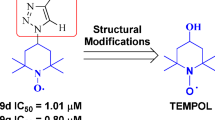Abstract
Herpes simplex virus is an important human pathogen responsible for a range of diseases from mild uncomplicated mucocutaneous infections to life-threatening ones. Currently, the emergence of Herpes simplex virus resistant strains increased the need for more effective and less cytotoxic drugs for Herpes treatment. In this work, we synthesized a series of oxoquinoline derivatives and experimentally evaluated the antiviral activity against acyclovir resistant HSV-1 strain as well as their cytotoxity profile. The most active compound (3b), named here as Fluoroxaq-3b, showed a promising profile with a better cytotoxicity profile than acyclovir. The theoretical analysis of the structure–activity relationship of these compounds revealed some stereoelectronic properties such as lower LUMO energy and lipophilicity, besides a higher polar surface area and number of hydrogen bond acceptor groups as important parameters for the antiviral activity. Fluoroxaq-3b showed a good oral theoretical bioavailability, according to Lipinski rule of five, with a promising profile for further in vivo analysis.



Similar content being viewed by others
References
Aurelian L (2008) Herpes simplex viruses: general features. In: Encyclopedia of virology, 3rd edn. Elsevier Ltd, Amsterdam, pp 383–397
Akhtar J, Shukla D (2009) Viral entry mechanisms: cellular and viral mediators of herpes simplex virus entry. FEBS J 276:7228–7236
Witt MN, Braun GS, Ihrler S et al (2009) Occurrence of HSV-1-induced pneumonitis in patients under standard immunosuppressive therapy for rheumatic, vasculitic, and connective tissue disease. BMC Pulm Med 18:22–30
Billaud G, Thouvenot D, Morfin F (2009) Drug targets in herpes simplex and Epstein Barr Virus infections. Infect Disord Drug Targets 9:117–125
Clercq ED (2010) In search of a selective therapy of viral infections. Antivir Res 85:19–24
Viera MH, Amini S, Huo R et al (2010) Herpes simplex virus and human papillomavirus genital infections: new and investigational therapeutic options. Int J Dermatol 49:733–749
Danve-Szatanek C, Aymard M, Thouvenot D et al (2004) Surveillance network for herpes simplex virus resistance to antiviral drugs: a three year follow-up. J Clin Microbiol 42:242–249
Morfin F, Thouvenot D (2003) Herpes simplex virus resistance to antiviral drugs. J Clin Virol 26:29–37
Lucero BA, Gomes CRB, Frugulhetti ICPP et al (2006) Synthesis and anti-HSV-1 activity of quinolonic acyclovir analogues. Bioorg Med Chem Lett 16:1010–1013
Souza TM, Souza MCB, Ferreira VF et al (2008) Inhibition of HSV-1 replication and HSV DNA polymerase by the chloroxoquinolinic ribonucleoside 6-chloro-1,4-dihydro-4-oxo-1-(β-d-ribofuranosyl) quinoline-3-carboxylic acid and its aglycone. Antivir Res 77:20–27
Duffin GF, Kendall JD (1948) Preparation of 4-hydroxyquinoline derivatives from aromatic amines and ethyl ethoxymethylenemalonate. J Chem Soc 70:893–894
Snyder HR, Freier HE, Kovacic P et al (1947) Synthesis of 4-hydroxyquinolines. VIII. Some halogen containing 4-aminoquinoline derivatives. J Am Chem Soc 69:371–374
Ruxer JM, Lachoux C, Ousset JB et al (1994) Synthesis of 1, 4-dihydro-4-oxopyrrolo[1, 2b]pyrazine-3-carboxylic acids and 1, 4-dihydro-4-oxoimidazo[1, 5-b]pyridazine-3-carboxyllic acids as antibacterial agents. J Heterocycl Chem 31:409–417
Ramadas K, Srinivasan N (1992) Iron-ammonium chloride—a convenient and inexpensive reductant. Synth Commun 22:3189–3195
Santos FC, Abreu P, Castro HC et al (2009) Synthesis, antiviral activity and molecular modeling of oxoquinoline derivatives. Bioorg Med Chem 17:5476–5481
Bernardino AM, Castro HC, Frugulhetti IC et al (2008) SAR of a series of anti-HSV-1 acridone derivatives, and a rational acridone-based design of a new anti-HSV-1 3H-benzo[b]pyrazolo[3, 4-h]-1, 6-naphthyridine series. Bioorg Med Chem 16:313–321
Mosmann T (1983) Rapid colorimetric assay for cellular growth and survival: application to proliferation and cytotoxicity assays. J Immunol Methods 65:55–63
Souza AM, Castro HC, Brito MA et al (2009) Leishmania amazonensis growth inhibitors: biological and theoretical features of sulfonamide 4-methoxychalcone derivatives. Curr Microbiol 59:374–379
Pinheiro LC, Abreu PA, Afonso IF et al (2008) Identification of a potential lead structure for designing new antimicrobials to treat infections caused by Staphylococcus epidermidis-resistant strains. Curr Microbiol 57:463–468
Lipinski CA, Lombardo F, Dominy BW et al (2001) Experimental and computational approaches to estimate solubility and permeability in drug discovery and development settings. Adv Drug Deliv Rev 23:3–25
Wermuth CG (2003) The practice of medicinal chemistry, 2nd edn. University of Louis Pasteur, Academic Press, San Diego, CA
Acknowledgments
We thank Conselho Nacional de Desenvolvimento Científico e Tecnológico (CNPq), Coordenação de Aperfeiçoamento de Pessoal Docente (CAPES Edital Nanobiotecnologia 2008) and Fundação de Amparo à Pesquisa do Estado do Rio de Janeiro (FAPERJ) for the financial support and fellowships. The technical assistance of Samara, Hania, and Juliana Novais is gratefully acknowledged.
Author information
Authors and Affiliations
Corresponding authors
Rights and permissions
About this article
Cite this article
Abreu, P.A., da Silva, V.A.G.G., Santos, F.C. et al. Oxoquinoline Derivatives: Identification and Structure–Activity Relationship (SAR) Analysis of New Anti-HSV-1 Agents. Curr Microbiol 62, 1349–1354 (2011). https://doi.org/10.1007/s00284-010-9860-6
Received:
Accepted:
Published:
Issue Date:
DOI: https://doi.org/10.1007/s00284-010-9860-6




